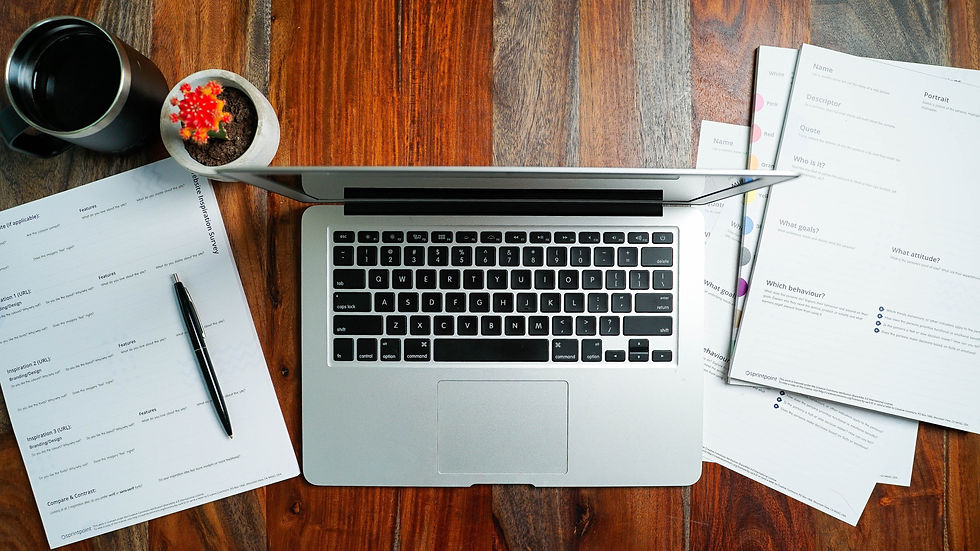Easy Read Guide to The Tank Museum
- Clare Tarling

- Oct 9, 2023
- 3 min read
I see my writing and design service as a journey, not a destination. The process behind every project is unique. I'd like to share one of my favourites!

The Sherman tank which was used in the film "Fury", in situ at the museum. Design This story starts in 2016, when a group of adults with learning disabilities from Muntsy's day service visited The Tank Museum in Dorset, England. The museum houses the largest collection of tanks in the world. It is an awe-inspiring place to visit. The group looked at the standard guidebook: too many words, in small print, with lots of photos set behind the text. An informative read for some, but completely inaccessible for everyone in this group. Their visit was followed with a workshop which was linked to the museum's “Warhorse” exhibition. The workshop was led by the museum’s Education Officer - Felicity Wood - who presented an absorbing and interactive session about the the role of horses in the First World War. She bought along bridles, rations, clothing: something for all the senses. After the workshop, I listened to the group’s ideas about improving the museum's guidebook. They wanted an accessible version, and they knew how they wanted it to look. They decided to make a scrap-book, to help them to think about where all the information should go. Once their scrap-book was finished, I was called back to turn it into something we could print. The museum created the maps and gathered photos. I pulled it all together in InDesign, and printed prototypes.

Testing
We all met up at the museum, and handed out the prototype booklets. First impressions were good! I watched closely as everyone opened the books and started to use them. First up: a double-page map. Almost everyone looked puzzled and then turned their books upside down. That needed fixing! We then walked around the whole museum, going through the booklet section-by-section.
Back to the office, map flipped around, a few other things fixed, and off to the printers. We were all delighted with the result!
Version 2
Fast-forward to 2023 and I am thrilled to say that we are updating the book! It is amazing to see how far the museum has come with accessibility in the last few years. There is now a wellbeing room (photo below), autism-friendly sessions (where the sounds are turned off), BSL tours, sensory backpacks to borrow, and tours which can be tailored for a range of different groups. There are also plans for a changing place, which is great to hear!

Wellbeing room at The Tank Museum
So what about the guidebook? We have improved the maps, deleted exhibitions which don't exist any more, and added some new exhibitions, such as "Tanks for the Memories: tanks in popular culture." I’ve had lots of good advice from Muntsy's again, about elements they want to keep, add, delete or improve. The museum's current Education Officer, Claire Cooper, is a joy to work with and has a wealth of knowledge about the exhibits, the diversity of the museum's visitors, and how to make museums inclusive and welcoming for all. Next, we will get a set of prototypes printed, and arrange yet another visit to test them out. What makes this project special?
Origins - the initial idea, the content and the layout came from the group of people with learning disabilities, not from me or from the museum
Location - creating the booklets in this unique and historic place has been essential for developing the designs and testing prototypes
Topic - most Easy Read information seems to be about health and social care, as if these things are always uppermost in people's lives. They are not! People are interested in a whole heap of things that are nothing at all to do with their disability, support needs or living arrangements. Lets get more Easy Read into museums, galleries, shops, concert venues, hotels, libraries, restaurants - the list is a long one!
Collaboration - this project is all about Muntsy’s, the museum and me, working in partnership, with the utmost respect for each other’s roles and expertise. This process and these relationships have ensured that we end up with the best possible guidebook.
Boundaries - we've had realistic and flexible expectations around consultation on drafts of the guidebook. I have seen co-production projects run into the sand because of endless revisions whilst trying to “please all the people”. That is not what co-production is about. Being clear about expectations, roles and deadlines really helps.
Improvement - it has been brilliant to have the opportunity to update the guidebook, 7 years later, with many of the original team who created version 1.
Leadership - I love working with organisations who are THIS ambitious about accessibility, inclusion, and contributing to their local communities. Without this passion and leadership, the project would never have left the starting blocks.
Thank you The Tank Museum and Muntsy's!





Pilihan game slot ada ratusan, gak bakal bosan. https://fctechno.com/kabar4d-aman-dan-terpercaya